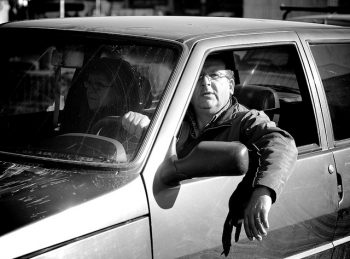The Many Drivers of Israel’s Streets Posted by Ayana on Dec 25, 2017 in Uncategorized
There are 22 letters in the Hebrew aleph-bet. These 22 basic units are the material from which the Hebrew language forms its consonantal roots. Putting two, three or four letters together creates a root. For example, the root כ-ת-ב (k-t-v), is composed of the 11th letter with the 22th letter plus the 2nd letter of the aleph-bet. 22 letters produce thousands of combinations, and molding them into fixed patterns turns the roots into words. The root bears a meaning, but this meaning will only get shape, tense and gender after inserted into a pattern.
One of the many patterns in Hebrew is קַטָּל, also called פַּעָל. This pattern has a connotative meaning of professional. Quite a few Hebrew words for professional are using this pattern. And all of them act according to the pattern, which means that they are all masculine, singular and punctuated the same. For example:
Upholsterer = רַפָּד
Carpenter = נַגָּר
Gardener = גַּנָּן
Hairdresser = סַפָּר
Janitor = שָׁרָת
Painter = צַבָּע
Glazier = זַגָּג
Kindergarten teacher = גַּנָּן
Tinsmith = פַּחָח
Watchmaker = שָׁעָן
Driver = נַהָג
There are several sorts of drivers (נַהָגִים) in Israel. The most common one is a bus driver (נַהַג אוֹטוֹבּוּס). I have a monthly ticket to the bus; I commute everyday by bus, and get around the city by bus. So I meet quite a few נַהָגֵי אוֹטוֹבּוּסin one day. None of them is like נַהַג הָאוֹטוֹבּוּס who used to drive us every day to school when I was a kid. His name was Yossi, he was big and strong, and had a thick mustache. My mom always told me as a kid, “never get on the אוֹטוֹבּוּס if the נַהָג is not Yossi”. And so I did, until I graduated elementary school.
High school buses were driven by different נַהָגִים. But we didn’t always take the bus. Sometimes we took a cab, and then the driver was a taxi driver (נַהַג מוֹנִית). To become נַהַג מוֹנִית in Israel one needs to be older than 21, with at least two years of experience as a נַהָג. If you want to be נַהַג מוֹנִית in Israel, you need to apply to The Department of Vehicles. The application should include a certificate of integrity from the police plus physical tests from the doctor. The Department of Vehicles will summon you to an interview to decide if you are valid to be a public driver. If you get the Department of Vehicles’ confirmation, you can register to a public car driver course. The course includes defensive driving, first aid, mechanic, and of course driving lessons.
Serving as a public driver in Israel is hard work, and the obstacles are unpredictable. Benny Bilevski, for example, is a bus driver for almost 50 years. He works on the route to Eilat, and one hot noon in August 2011 terrorists opened fire at his bus. In this short video Benny is talking about his work, and his respond to the terror attack:
If you want to make a living as a car driver but don’t want to be a public one you, can always be a private driver (נַהַג פְּרָטִי). My good friend was surprised by her boyfriend last year on her birthday. He hired for her נַהַג פְּרָטִי for one day, who escorted them all day long to the shops and the spa.
נַהַג אוֹטוֹבּוּס, נַהַג מוֹנִית and נַהַג פְּרָטִי drive people. Track driver (נַהַג מַשָּׂאִית), on the other hand, transports commodities, equipment and other goods. Military driver (נַהַג צְבָאׅי) can transports both, depends on his rule and the situation. נַהַג בּוֺס (boss’ driver) is an Israeli phrase referring to a military driver who serves as a commander’s driver. It considered to be a good job because only high rank commanders get nice cars and private drivers. But in such job there is no routine, and the נַהַג בּוֺס spends long hours waiting for his boss.
To all the drivers you will encounter in Israel, you can sing the famous Hebrew nursery, called אחינו הנהג (our brother, the driver):
Text vocabulary
A driver (masculine) = נַהָג
A driver (feminine) = נַהֶגֶת
Drivers (masculine) = נַהָגִים
Drivers (feminine) = נַהָגוֺת
A bus driver (masculine) = נַהַג אוֹטוֹבּוּס
A bus driver (feminine) = נַהֶגֶת אוֹטוֹבּוּס
The bus driver = נַהַג הָאוֹטוֹבּוּס
Bus drivers = נַהָגֵי אוֹטוֹבּוּס
Taxi driver = נַהַג מוֹנִית
Private driver = נַהַג פְּרָטִי
Track driver = נַהַג מַשָּׂאִית
Military driver = נַהַג צְבָאׅי
Boss’ driver = נַהַג בּוֺס
Keep Calm and Drive Safe

Build vocabulary, practice pronunciation, and more with Transparent Language Online. Available anytime, anywhere, on any device.





Comments:
MH:
This post was great and I really enjoyed the videos you included 🙂 תודה רבה
Ayana:
@MH Thank you so much! I’m glad you enjoyed it 🙂